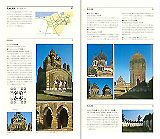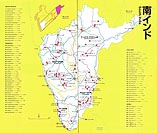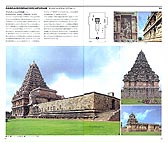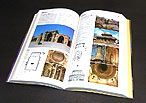
| The Guide to the ARCHITECTURE
|

A guidebook surveying more than 600 monuments of all India
with Bangladesh, in geographical order from North to South.
It consists of 5 chapters of North, East, West, Middle and South India.
Each chapter is divided into several States
which have title pages describing the architectural features.
The book is a useful compilation of Indian architecture
with 1,800 colour photographs, 300 maps and plans, and text.
|
Unfortunately there are numerous mistakes and omissions in the English translation in almost all pages because of the absence of any architectural historian's supervision on the English side. The publisher promised to make a corrected edition under the aid of Mr A. M. Dhaky, one of the best architectural historians in India, but he has not done it after all. (01/10/2003, Takeo Kamiya, author) |
Mandira Nayar
( In "THE HINDU", September 4, 2003 )
This is a chance to travel across India from Kashmir to Kanyakumari with a Japanese "guide." A perfect handbook for travelers and building lovers, "The Guide to the Architecture of the Indian Subcontinent" by Takeo Kamiya is a bible of Indian architecture, claims architect Gerard da Cunha. And having explored every nook and cranny of the country for 20 years, he is now ready to take people around the country without an interpreter.
With all the major monuments photographed recommended by the architect fraternity. "I wish I had a book like this when I was a student of architecture. It is uncanny. This is what I wanted to do: travel the length and breadth of the country and document our architectural heritage. I never had the time to do it and then I together by Takeo Kamiya, a Japanese architect. We had a big team to translate this into English," says da Cunha.
Detarmined to discover more than just western architecture, Kamiya came to India armed with a special lens and a spirit of adventure. "When I was studying architecture in Japan everyone looked only towards European and American buildings. Growing up we believed that architecture thrived only in this triangular world. In Japan, when an architect wants to branch on his own, he generally travel to study building abroad. While all my contemporaries were traveling to Europe and America, I decided to go to India -- the land where the Buddha was born," says Kamiya.
More than 10 field trips and 20,000 pictures later, Kamiya decided to give Japanese architects a taste of exotic India. "I also went to Egypt, Middle East, and Mexico, but the kind of diversity that India has in architecture no other country has. There are buildings of one kind and suddenly there is another building of a completely different kind. It was very tough to travel in India. I didn't know the language and getting to the places was not easy. But when I finally reached a building, I felt it was all worth it," he says.
A little bit about famous buildings and some information about unknown buidings which never make it to a tourist guide, Kamiya's book gives readers bitten by the travel bug just another reason to pack and move. And for those who don't know where to go -- "The Guide to the Architecture of the Ino don't know where to go -- "The Guide to the Architecture of the Indian Subcontinent" might prove to be very useful.
|

C.R. Jayachandran
( In the "TIMES OF INDIA", September 6, 2003 )

Lakshmi Nagappan
( In the “MADRAS PLUS” October 4th, 2003 )
This calls for monkish discipline indeed. And when you require commitment you cannot get a more devoted and regimented a race than the Japanese. Takeo Kamiya is one such. His "The Guide to the Architecture of the Indian Subcontinent" is as meticulous and codified as a tea ceremony in his home. It describes the architectonic significance of 527 monuments spread across our land with the exception of a few unassailable North-Eastern states. Part of Bangladesh has been covered though.
You may not as yet be sparked by this Japanese architect's effort, but read on, for, as Indian architect Gerard Cunha who has published the English version of Kamiya's handbook, explains, "What sets Kamiya's work apart is the fact that he has not relied on a secondary source." Kamiya has crisscrossed India intermittently for the past 20 years, much more than us crores of Indians, and has single-handedly provided this first-hand account.
What is even more outstanding is that Kamiya did not tie up with any organization in India to chalk out the logistics of his roving or fund it, not that he could easily afford it either. Our tourism ministry has just done the least by honoring him as a guest of the government of India, which means they take care of his travel expenses to and from Japan and extend him free boarding as well.

Why did Kamiya choose to do us Indians this painstaking favor ? Responds he, "I have traveled widely, but no where in the world have I seen a continuation in culture and architecture from the ancient to the present. India is an exception." This Huien Tsang of our times has catalogued our period structures that date back to 3,000 years ago up to the end of the 20th century. Amazingly it is not the Taj that Kamiya is ensorcelled by, but the magnetism of the wooden temples of Himachal and in particular the Adinatha Temple at Ranakpur in Rajasthan. "I have classified world architecture into three categories, post and beam, sculpture based and membranous. In the Ranakpur temple, all three kinds exist," says Kamiya. In Tamil Nadu, he prefers Mahabalipuram, which embodies the start of stone as a material for construction in South India. Kamiya himself incorporates much of Indianness in his compositions in Japan, for example the Mughal concept of enclosed gardens, et al. Kamiya's book is a bible for most Japanese who wish to travel to India and was hitherto clueless for there was no authentic Japanese manual on traveling in India. We Indians too may not have had the pleasure of this superb chronicle if it had not been for Gerard, who organized the translation. The translator is Geetha Parameshwaran who subtitled Rajnikanth blockbusters for the Japanese audience.
Gerard is acclaimed for his vernacular constructions. He employs a lot of laterite, the local stone of Goa, where he is based. He recently won the National Award for Excellence in Urban Planning. Readers might recognize Gerard better for the earthy dance village that he conceptualized for Protima Bedi.
 |
| Map Index, Getting Aroound | 008 | |
| AN INTRODUCTION TO INDIAN ARCHITECTURE | 012 | |
| NORTH | Travel Information [ North India ] | 020 |
| INDIA | JAMMU & KASHMIR | 024 |
| ( Kashmir ) 1 Srinagar / 2 Martand / 3 Avantipur / 4 Buniyar / 5 Payar / 6 Achhabal / 7 Vreinag / 8 Jammu | ||
| ( Ladakh ) 9 Lamayuru / 10 Temisgan / 11 Rizong / 12 Saspol / 13 Likir / 14 Alchi / 15 Leh / 16 Stok / 17 Phyang / 18 Shey / 19 Tikse / 20 Chemre / 21 Hemis | ||
| HIMACHAL PRADESH | 056 | |
| 22 Chamba / 23 Bharmaur / 24 Masrur / 25 Baijnath / 26 Diyar / 27 Khokhan / 28 Manali / 29 Nagar / 30 Bajaura / 31 Kamru / 32 Sungra / 33 Sarahan (northern) / 34 Ranpur / 35 Shimla / 36 Manan / 37 Sainj / 38 Balag / 39 Hatkoti / 40 Khadaran / 41 Sarahan (southern) | ||
| PUNJAB | 078 | |
| 42 Amritsar / 43 Chandigarh / 44 Pinjore | ||
| DELHI | 086 | |
| 45 Delhi / New Delhi | ||
| UTTAR PRADESH | 102 | |
| 46 Brindavan / 47 Agra / 48 Sikandra / 49 Fatehpur Sikri / 50 Lucknow / 51 Jaunpur / 52 Allahabad / 53 Sarnath / 54 Baranasi | ||
| EAST | Travel Information [ East India ] | 140 |
| INDIA | SIKKIM | 144 |
| 1 Rumtek / 2 Labrang / 3 Pemayangtse / 4 Tashiding | ||
| BIHAR | 148 | |
| 5 Vaisali / 6 Patna / 7 Maner / 8 Barabar Hill / 9 Nalanda / 10 Bodhgaya / 11 Sasaram | ||
| WEST BENGAL | 156 | |
| 12 Gaur / 13 Pandua / 14 Murshidabad / 15 Bardhaman / 16 Baranagar / 17 Ghurisa / 18 Barakar / 19 Hadal-Narayanpur / 20 Bishunupur / 21 Kalna / 22 Guptipala / 23 Bansberia / 24 Atpur / 25 Kolkata (Calcuttta) | ||
| BANGLADESH | 178 | |
| 26 Kantanagar / 27 Kusumbha / 28 Paharpur / 29 Pabna / 30 Puthia / 31 Dhaka / 32 Sonargaon / 33 Comilla | ||
| ORISSA | 188 | |
| 34 Khandagiri, Udayagiri / 35 Ratnagiri / 36 Udayagiri / 37 Bhubaneshwar / 38 Dhauli / 39 Haripur / 40 Puri / 41 Konarka / 42 Chaurasi / 43 Mukhalingam | ||
| WEST | Travel Information [ West India ] | 208 |
| INDIA | RAJASTHAN | 214 |
| 1 Alwar / 2 Deeg / 3 Abhaneri / 4 Jaipur / 5 Amber / 6 Sanganer / 7 Ajmer / 8 Pushkar / 9 Bikaner / 10 Jodhpur / 11 Mandor / 12 Kiradu / 13 Osian / 14 Jaisalmer / 15 Mount Abu / 16 Ranakpur / 17 Varkana / 18 Kumbhalgarh / 19 Udaipur / 20 Rajasamand / 21 Nagda / 22 Jagat / 23 Chittaurgarh / 24 Menal / 25 Dungarpur / 26 Bijolia / 27 Baroli / 28 Bundi | ||
| GUJARAT | 266 | |
| 29 Kumbharia / 30 Taranga / 31 Abhapur / 32 Roda / 33 Vadnagar / 34 Patan / 35 Modhera / 36 Ahmadabad / 37 Adalaj / 38 Sarkej / 39 Mahmedabad / 40 Gandhinagar / 41 Vaso / 42 Vadodara / 43 Chahmpaner / 44 Sevasi / 45 Wadhwan / 46 Lothal / 47 Morvi / 48 Sejakpur / 49 Wankaner / 50 Shatrunjaya Hills / 51 Junagadh / 52 Girnar / 53 Diu / 54 Somnath / 55 Ghumli / 56 Gop / 57 Dwarka / 58 Bhuj / 59 Kutch | ||
| MIDDLE | Travel Information [ Middle India ] | 310 |
| INDIA | MADHYA PRADESH | 316 |
| 1 Khajuraho / 2 Nachna / 3 Tigawa / 4 Chanderi / 5 Sirpur / 6 Rajim / 7 Gwalior / 8 Naresar / 9 Sonagiri / 10 Datiya / 11 Orchha / 12 Deogarh / 13 Chanderi / 14 Badoh Patari / 15 Udayapur / 16 Gyaraspur / 17 Udayagiri / 18 Sanchi / 19 Damnar / 20 Ujjain / 21 Dhar / 22 Mandu | ||
| MAHARASHTRA | 360 | |
| 23 Ajanta / 24 Pitalkhora / 25 Ellora / 26 Aurangabad / 27 Daulatabad / 28 Khuldabad / 29 Nasik / 30 Sinnar / 31 Junnar / 32 Mumbai (Bombay) / 33 Elephanta / 34 Kanheri / 35 Bedsa / 36 Bhaja / 37 Karli / 38 Pune / 39 Ter / 40 Raigarh / 41 Satara / 42 Mahuli / 43 Kolhapur | ||
| GOA | 396 | |
| 44 Old Goa / 45 Ponda / 46 Panaji | ||
| SOUTH | Travel Information [ South India ] | 404 |
| INDIA | ANDRA PRADESH | 408 |
| 1 Simhachalam / 2 Warangal / 3 Hanamkonda / 4 Palampet / 5 Hyderabad / 6 Golconda / 7 Chezarla / 8 Nagarjunakonda / 9 Srisailam / 10 Alampur / 11 Tadpatri / 12 Ahobilam / 13 Satyavolu / 14 Bhairavakonda / 15 Chandragiri / 16 Penukonda / 17 Lepakushi | ||
| KARNATAKA | 420 | |
| 18 Gulbarga / 19 Bidar / 20 Bijapur / 21 Badami / 22 Pattadakal / 23 Mahakuta / 24 Aihole / 25 Degamve / 26 Dambal / 27 Kukkanur / 28 Ittagi / 29 Lakkundi / 30 Kuruvatti / 31 Hampi / 32 Haveri / 33 Keladi / 34 Ikkeri / 35 Bhatkal / 36 Mangalore / 37 Sringeri / 38 Karkal / 39 Mudabidri / 40 Halebid / 41 Belavadi / 42 Belur / 43 Dodda Gaddavalli / 44 Harnahalli / 45 Kambadahalli / 46 Shravanabelgola / 47 Mysore / 48 Srirangapatnam / 49 Somnathpur / 50 Aralaguppe / 51 Nandi / 52 Bangalore | ||
| TAMIL NADU | 474 | |
| 53 Chennai (Madras) / 54 Mahabalipuram / 55 Tiruttani / 56 Tirukkalikundram / 57 Kanchipuram / 58 vellor / 59 Tiruvannamalai / 60 Gingee / 61 Panamalai / 62 Chidambaram / 63 Pondicherry / 64 Auroville / 65 Gangaiconda cholapuram / 66 Kumbakonam / 67 Tribhuvanam / 68 Darasuram / 69 Thiruvarur / 70 Srirangam / 71 Srinivasanallur / 72 Kodumbalur / 73 Thanjavur / 74 Narthamalai / 75 Rameshwaram / 76 Madurai / 77 Kalugumalai / 78 Padmanabhapuram | ||
| KERALA | 514 | |
| 79 Payyannur / 80 Calicut (Kozhikode) / 81 Trichur (Thrissur) / 82 Cochin (Kochi) / 83 Peruvanam / 84 Ettumanur / 85 Vaikom / 86 Tiruvalla / 87 Kaviyur / 88 Kazakuttam / 89 Triovandrum (Thiruvananthapuram) | ||
| DATA & INDEX | 529 | |
| Glossary | ||
| Bibliography | ||
| Index of Architects | ||
| Index of Places and Buildings | ||
| General Index | ||
| Indian Architectural History - Timeline | ||
| POSTSCRIPT | 572 | |
